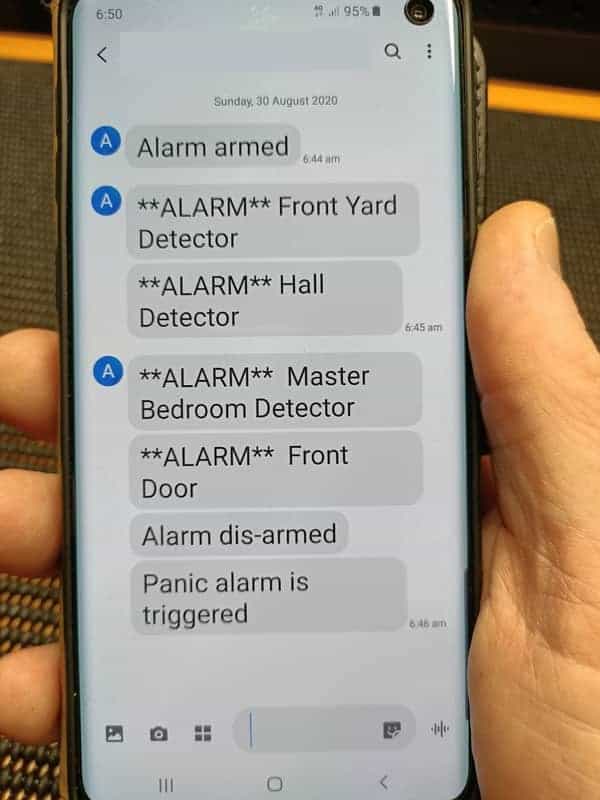Looking to join the growing number of homeowners and businesses that want to monitor their own alarm systems?
The good news is that if your alarm is already monitored by a professional monitoring company using your phone line, converting your existing alarm to self-monitoring is easy. There are 3 methods to self monitor your alarm system: mobile phone alert, text message alert and smartphone notifications. The methods available for you will depend on the equipment installed at your home or office.I’ll cover all three in a minute.
As long as your existing alarm has an analog can get the system converted to basic mobile phone monitoring in less than an hour.
Here’s what to do:
1 – Write down the brand and model of your alarm system. You can find this on the code pad, control panel or user manual.
2 – Ring 3 local security companies and ask for a quote to reprogram your alarm to dial your mobile phone if the alarm is triggered. Make sure you ask for a fixed quote. An inexperienced technician may not be familiar with your system and will happily charge you while he flips through the manual or rings a senior technician for help.
3 – Pick the cheapest quote
4 – When the technician arrives give him a list of numbers that you want your alarm system to contact. Most systems can dial at least 3 numbers. Ask the technician to remove ‘system events’ and open/close reports. You don’t want to be notified of those if you only have basic mobile phone alerts.
Three Types of Self Monitoring
1 – Mobile Phone Alert
This is a simple, low cost but effective of monitoring your alarm system. If the alarm is triggered, the alarm panel will call the first phone number programmed into its memory. When the call is answered, the alarm system plays a ‘siren tone’ down the line. That informs you that the alarm system has been triggered.
If the phone is not answered. the alarm panel will hang up and dial the second number, then the third. It will typically make up to six attempts to contact you or someone on your response team.
This method doesn’t tell you which sensor has been triggered. Nor can it inform you of mains fail or low battery conditions.
2 – Text Message Alert
Now we can get some specific information when the alarm is triggered. You’ll receive a message every time the alarm is armed and disarmed. You’ll also receive a detailed message if the alarm is triggered. For example:

More Information For Accurate Response
That extra information can help you decide the best way to respond. In the above example, you could assume the person arriving home was a bit slow in disarming the system so a priority response wouldn’t be necessary.
It’s also possible for you to remotely arm and disarm the alarm by sending a text message. This can be really handy if you leave the house and have forgotten to arm the system. You can also scroll through previous text messages and check when the system was armed or disarmed.
Universal Text Message Module
Most alarm panels don’t have the facility to send text messages out of the box so a Text Message Module is required for this functionality.

There are several available. The module I use is this unit from the DIY Alarm Guy. I like it because it can send text messages to five mobile phones and you can customize the alarms that are sent to each user. For example, you as the system owner would probably want all the events and alarm sent to your phone. These messages include:
- Alarm messages
- Alarm armed and alarm disarmed messages
- System ‘events’ such as mains fail, low battery, zone bypassed
If you have a neighbor or friend as part of your response team you can just send them alarm messages. You don’t necessarily want everyone to know your comings and goings.
You can install the module yourself, or have a competent alarm technician do the job – it shouldn’t take longer than an hour.
No Phone Line Needed
Your alarm panel doesn’t need a phone line for this. The only requirement is that you provide SIM card on a low monthly plan. $5.00 plans are readily available. Your alarm panel also needs to have a built-in auto dialler capable of communicating in Ademco Contact-ID format. Most systems that are less than 20 years old will.
Another advantage this unit has over its rivals is the ability for you to control 2 separate outputs by sending an SMS message. I use one to arm and disarm my system and another to open my garage door.
3 – App Control with Instant Notifications (and Video Verification)
If basic mobile phone monitoring and text messages are a bit low-tech for you, you should consider adding a few bits and pieces to your existing system and converting it to a Smart Alarm. For less than the cost of a new system you get an enormous amount of functionality including:
- A free app to arm and disarm your alarm
- Receive alarm instant notifications if a sensor is triggered
- Control your garage door, sprinklers, garden lights -anything that can be turned on and off
- Use your existing hardwired motion sensors sirens and strobe.
- Add High Definition CCTV cameras to verify alarms. Or just login at any time to see what’s going on. Images are stored in the cloud for 15 days. There are no fees whatsoever. It’s a very compelling feature to have.

I’ve used several systems over the last few years to upgrade older systems to ‘Smart’ systems. None offer all the functionality I’d like in a reasonably priced ‘Smart alarm’. Although the HikVision Axiom comes pretty close.
If you can track one down yourself, you’ll pay around $500.00 (Australian) for the parts you need to upgrade an existing hardwired alarm with 3 existing hardwired motion sensors. (excluding HD cameras)
Expect to pay an installer to around $250.00 to convert your system you can end up with a really versatile system for a lot less than a new system with the same features.
If you have a few minutes to spare, call two or three alarm installation companies. Ask them for a ball-park quote for a system with the capabilities of the Hivision Axiom
Disadvantages of Self Monitoring
It’s easy to see the advantages of monitoring your own alarm system but you should also consider the disadvantages:
- You could miss an important alert if you’re on the phone or don’t have mobile coverage
- Your insurance company may deny a claim if having a professionally monitored security system is part of their agreement with you.
- You may also be receiving a discount on your insurance premium if you have a monitored alarm.
- You or someone in your response team doesn’t know what to do if they receive an alarm from your home.
What To Do If You Receive an Alarm From Your System
Part of taking the responsibility for monitoring your own security system is to have a response plan. You really need two response plans: one for an alarm that occurs when your home and another for an alarm that occurs while you’re away from the house.

When You’re Home
The worst possible situation to be in is waking up to your alarming sirens screaming. It’s going to be difficult to have a measured thoughtful response in that situation. You have to assume there’s an intruder in the house. But it could also be a false alarm You’re options are pretty limited.
It’s a situation that can be avoided with a bit of planning.
1 – Have your system set up so that when you arm your system in Stay mode, only the outside siren operates. Have the internal sirens disabled
2 – Have a low-level buzzer in your bedroom that also activates when your alarm is triggered at night. It will provide a persistent alert tone to wake you without scaring the wits out of you.
If you’re not sure how to do this, call a qualified technician to do it for you.
3 – Consider a low cost wireless perimeter alarm that you can activate when you’re at home. It will provide an early warning that someone is snooping around before they get inside your home.
When You’re Away
Self-monitoring works well when you also have at least one low-cost camera installed in your home. If you receive an alarm notification you can log on to the camera and see why the alarm is activated. If it’s because you’ve left a window open or the cat has jumped up on the table, you can simply disarm the system, bypass the sensor in the area causing the alarm, then re-arm the system.
And if you don’t have a camera, you can call a friend or neighbor to drive past your house and see if they can see anything unusual going on. Otherwise, you’d have to wait til you returned home to see if the alarm was genuine or not.
If you see a stranger in your house you can contact the police and let them know you have visual verification of a break-in underway at your home
These are just suggestions.The response plan you decide on will be completely up you.
In Conclusion
Professional monitoring companies are battling to retain monitored customers, especially in the residential sector. The larger companies have started automating some ‘non-urgent’ alarms so they don’t need to employ so many staff in the monitoring centers. That means you might only receive a text message or automated voice if your alarm is triggered. In this case why wouldn’t you monitor the system yourself?
Of course, there will always be a place for professional monitoring but you need to know exactly what you’re getting for your monitoring fee.
In some districts, the police won’t even attend an alarm call from a monitoring centre unless the homeowner (or a patrolman) confirms that a break-in has occurred.
If you don’t regard yourself as a high-risk target, modern self-monitoring technology offers you a virtually free (and in some ways superior) monitoring service.
In any case, I hope you learned something!
